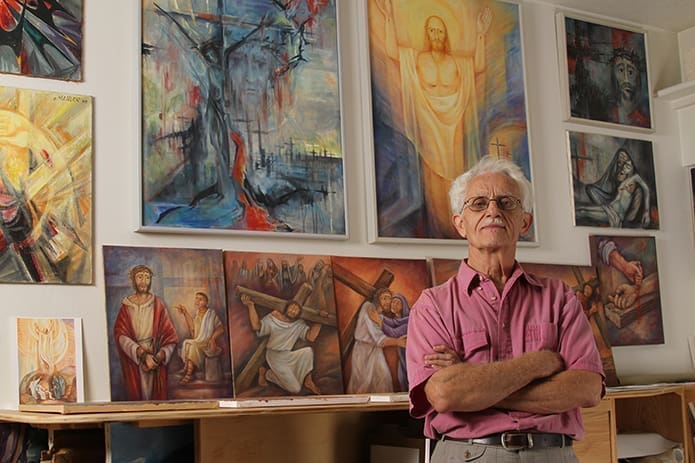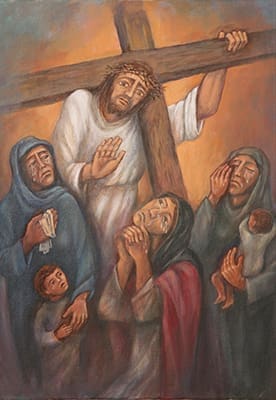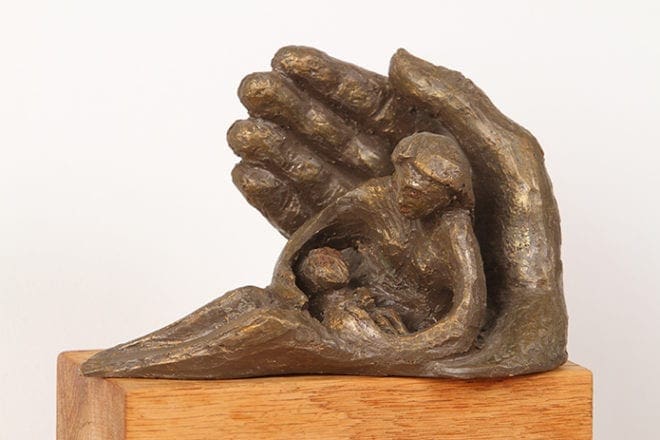 Photo By Michael Alexander
Photo By Michael Alexander Clarkesville
Artist’s work reveals his faith
By NICHOLE GOLDEN, Staff Writer | Published October 24, 2013
CLARKESVILLE—The trees of north Georgia are turning to shades of orange, yellow and red. The fields are gold and green, and the lawn of St. Paul the Apostle Church in Cleveland has become a patch of pumpkins in rows of various sizes.
Between Clarkesville and Cleveland, and just around the corner from the alpine village of Helen, German-born artist Josef Mahler makes his home on a hillside.

Josef Mahler illustrates Jesus meeting the women. The painting is one in a series of images he started creating surrounding the Way of the Cross after Easter, 2013. Mahler plans to complete the entire series by the end of Lent, 2014. Photo By Michael Alexander
The marked change in seasons is one reason Mahler moved to Georgia from Florida. Mahler and his wife, Helga, and three daughters, immigrated to the United States in 1983, first living in Cape Coral, Fla.
Born in 1938 in Wurzburg, Germany, Mahler discovered art early in life. “I was 12 years old,” he said.
With a Benedictine monastery in the neighborhood, Mahler learned about drawing from one of the monks. The monk taught him perspective in drawing, picked up on the young boy’s natural talent and suggested further art training.
Mahler’s parents were unsure of how Josef, one of 11 children, could support himself as an artist.
Times had been hard during World War II for the Bavarian family of seven sons and four daughters. Mahler’s father was on the “black list” of the Gestapo during the Nazi regime for his support of the monks.
The children learned to be wary of “every car that came in the driveway.” His father even had a bunker where he could hide if needed. A family friend was sent to a concentration camp for four years for speaking against the Nazis.
The family had access to a “little radio” and would listen to BBC reports to learn that the Americans were inching closer all the time.
The rebuilding of Germany was a happier time with even a single potato to eat a cause for celebration, recalled Helga.
By 1952, Josef was attending art school, Kunst-und Handwerker Schule. He was the youngest student to receive a scholarship. The other students came from more well-to-do families.
“I was the youngest, the smallest and the poorest in the art school,” said Mahler. “I had one pair of shoes.”
Josef had to leave his home at 6 a.m. to be at the school by 8 a.m.
“It took two and a half hours in the evening to get home, ” he said.
When one has received a scholarship, they must work harder. “You have to be good,” noted Mahler.
In 1957 he received his degree in graphic design and commercial art. In 1960, he studied religious art at the Franciscan Eremitage near Regensburg, Germany.
Mahler did not limit his education to just painting or drawing but instead tried to learn everything. “You never know enough,” he said.
Mahler’s work throughout the years has included various media: oil and acrylic paintings, watercolors, murals, mosaics, copper work, plaster and stucco in three-dimensional art, ceramics and designing and painting stained glass windows. He has received numerous awards for artwork commissioned by kindergartens, high schools, churches and various departments of government.
The painting of the Stations of the Cross on glass for his hometown church was Mahler’s first project as a freelance artist.
For more than 35 years, Mahler designed graphics for the publishing house, International Image & Church Media, which publishes materials in 40 countries worldwide.
In 1997, the Mahlers settled in Sautee, Georgia, and the region reminds them a bit of their native home in Bavaria. “It’s farmland. … It’s green,” said Mahler.
Josef Mahler’s studio, although packed with masterpieces and supplies, is neat as a pin and filled with natural light. The studio space is situated on the first floor of the couple’s home, allowing Josef to paint daily. He often listens to music while creating his works.

In addition to oil and acrylic paintings, Josef Mahler also works with ceramics. This bronze-colored ceramic piece is entitled “In God’s Hands.” Photo By Michael Alexander
The home itself is like an art gallery featuring both Mahler’s religious and non-religious works. The upstairs living area features a ceiling mural of a German landscape so their homeland is never far away. “We are not getting homesick,” said Helga.
The window of an upstairs dining alcove provides a breathtaking view of the north Georgia mountains. Much of their furniture is Mahler’s handiwork.
Murals also adorn the walls in an outside patio area where the extended family entertains guests during Helen’s Oktoberfest and throughout the year.
“We like to celebrate,” said Mahler about their love of fellowship.
A parishioner at St. Mark Church in Clarkesville, Mahler designed two large stained glass windows for the parish in 2003. He was also commissioned to paint two large murals, which are located inside the church entrance and were completed in 2005. His work is featured in the book, “The Archdiocese of Atlanta: A History.” The stunning mural is 17 feet wide and nine feet high.
Titled, “The Road to Emmaus,” the mural shows how all are connected to Jesus’ walk and are to continue to spread his word.
Mahler’s pen and ink drawings are featured in the weekly bulletins at both St. Mark and neighboring parish St. Paul the Apostle and illustrate the Sunday Gospel readings for each week. He is currently working on a letterhead design for St. Mark featuring the lion, the symbol of this disciple of Christ.
Mahler also painted mural scenes for St. Leo Church in Inwood, W.V., and was completing that project when Pope John Paul II died. He added the likeness of Blessed John Paul on the mural called “Follow Me and I Will Make You Fishers of Men.”
A second painting for the Inwood church’s high niche depicts the life of St. Leo the Great. On the left, St. Leo meets Attila the Hun outside of Rome. The center shows the pope seated on his papal throne with Sts. Peter and Paul—the patron saints of Rome—behind him. To the right, the pope instructs his bishops and priest on matters of Catholic theology and ministers to the poor.
Around the world, visitors to the Rosary Chapel in Schwarzach, Germany, are inspired in prayer by Mahler’s scenes of the life of Christ.
Back at home, St. Mark’s pastor Father José-Luis Hernandez-Ayala invited Mahler to exhibit works about Christ’s Passion and Easter at the church this year.
Mahler said the works ranged “like the story” from the Mount of Olives through Good Friday and beyond.

Josef Mahler painted the nailing of Jesus to the cross. Mahler said he prefers to focus on the human component of Jesus as a person who suffered for us. Photo By Michael Alexander
Mahler frequently paints the Stations of the Cross. “I like to do it,” he said.
Some people like the more traditional depictions, yet Mahler also paints different interpretations. For the Second Station (Jesus takes up the cross), Mahler sometimes adds other images such as a person in a wheelchair or someone suffering with cancer.
“Other people take the cross too,” he explained.
For a crucifixion scene, Mahler sometimes adds the others who were there, such as the women or a Roman soldier. But he explained, that the add-ons aren’t really needed.
“That’s the most important,” he said, pointing to Jesus on the cross.
For each painting, window design or sculpted scenes, he does several sketches first. One of his current projects is a painting of Mary holding Jesus. His design sits on an easel and is pieced from parts of two sketches.
Mahler also paints images of the saints, his favorite being St. Francis of Assisi.
Working with light plasters or drywall-like materials, Mahler also sculpts scenes that appear to be heavier woodcarvings or metalworks at first glance.
While trained in pottery, he no longer works in the medium. “It’s too much stuff,” he said.
Mahler also paints non-religious modern and abstract pieces often with messages of fighting against love of money and power. The Mahlers, married for 52 years, need only look back to their childhood days to recall what problems the love of power created for a country.
“We go through the Nazi time,” said Mahler. Then they witnessed the rise of communism next door.
To celebrate the fall of the Berlin Wall, Mahler set the history of the wall on an enormous canvas, a 16-by 4-foot oil painting.
“I wanted to record this history so that it is never repeated,” he noted.
For Mahler creating religious art is not about profit or financial gain.
“Money is not anything,” said Helga.
“I could not look in the mirror in the morning,” said Josef. “First I am human and a Catholic.”
To see Josef Mahler’s works, visit www.artstudiomahler.com.